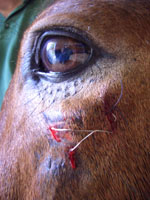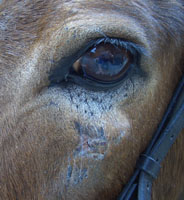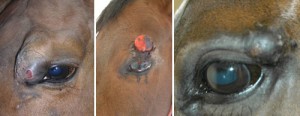At left: Muffin the mule had irradiated wires sutured into the site where his sarcoid tumor emerged from the skin beneath the eye. In the image below, you will see the tumor site after the wires were removed. (Animal Health Trusts photos)Sarcoids are the most common form of tumor in horses, donkeys and mules worldwide. Some animals get just a single sarcoid, whereas others may have multiple tumors. The tumors remain within the skin, but can grow and become ulcerated. They can be painful and, if close to the eye, can have a significant effect on vision.

The equine veterinary clinicians of the world are concerned at what appears to be either an increase in the incidence of sarcoids in horses, or at least an increase in the number of cases referred for treatment.
At the Animal Health Trust’s equine clinic in Newmarket, England, referrals and research for all sorts of horse-related diseases and lameness problems are common. Some of the world’s top sport and race horses are vanned in and out of the clinic. But recently, the clinics were able to help Muffin, a pet mule who resides at the Redwings horse sanctuary nearby.
Sadly, over the past two years, Muffin has needed to spend much of his time in veterinary care while his sarcoid was being treated. Despite a variety of treatments the tumor became more advanced and so Muffin was on his way to the Animal Health Trust for the latest treatment.
Muffin’s sarcoid is below the eye and since it is relatively small, it is not affecting his sight. However, it is likely to be causing soreness and irritation, and now that it has become ulcerated, it is likely to attract flies.

Redwings veterinarian Ruth Morgan said, “We tried all the standard treatments, including creams and a course of chemotherapy; but when we heard that the oncology team at the Animal Health Trust had started treating these sarcoids in horses with iridium, we knew that would be Muffin’s best chance. We were very concerned to treat the condition effectively before it spread closer to his eye and became painful.”
The Animal Health Trust’s oncologists used a specialized technique known as brachytherapy, which is a form of radiotherapy. This is often the treatment of choice for periocular (around the eye) tumors and also sarcoids that appear at joint sites.
When sarcoids are located on other areas of the body, treatment options vary. Surgical excision often results in aggressive recurrence of the tumor, and so is rarely advocated as a sole treatment. Cryotherapy (topical freezing), Bacillus Calmette-Guerin (BCG) immunotherapy, and CO2 laser excision have all been used with varying success. Intralesional treatment with cisplatin or with a cytotoxic cream developed at the University of Liverpool may be options where the sarcoid is in a location suitable for topical treatment, according to the AHT.
Meredith Smith, the AHT Equine Clinician responsible for Muffin’s treatment, explained, “I inserted wires impregnated with a radioactive material (Iridium-192) into the affected area. This is a gold standard of treatment particularly suited to this type of tumor. I am very hopeful that it will improve Muffin’s quality of life significantly. To date, we have had a 100% success rate using this therapy although, to the best of my knowledge, it has not previously been used on a mule.”
Click on this file name’s link to download a pdf file from the Animal Health Trust’s oncology department explaining much more about brachytherapy for equine sarcoids: AHT_equine_iridium.pdf.
Additional images of equine sarcoids provided by the Animal Health Trust









